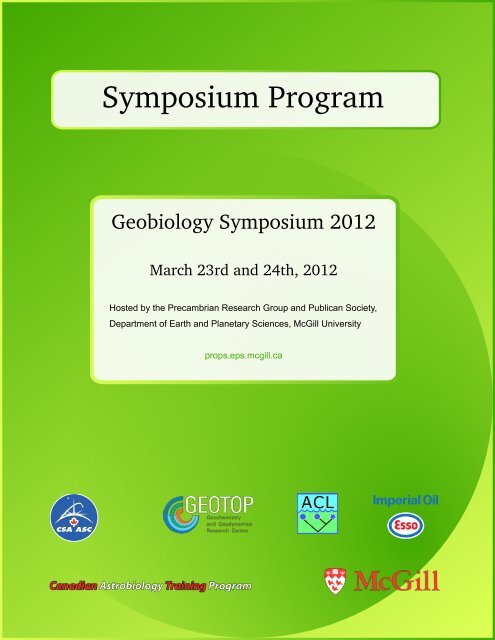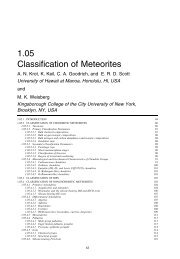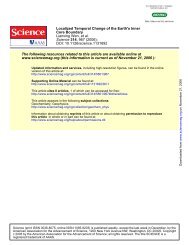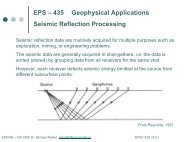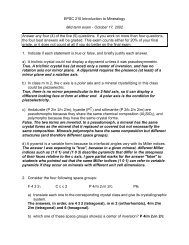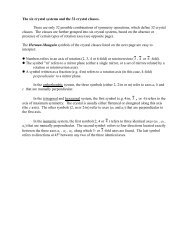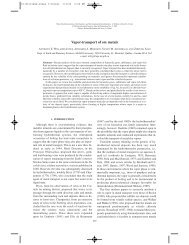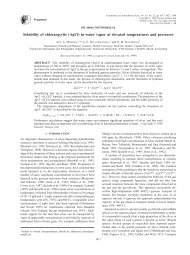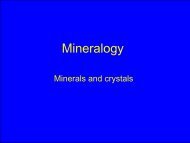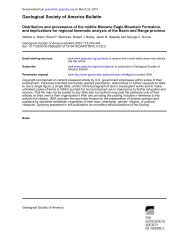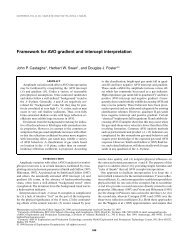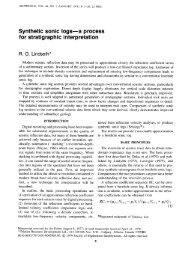Symposium Program - Precambrian Research Office - McGill ...
Symposium Program - Precambrian Research Office - McGill ...
Symposium Program - Precambrian Research Office - McGill ...
You also want an ePaper? Increase the reach of your titles
YUMPU automatically turns print PDFs into web optimized ePapers that Google loves.
<strong>Symposium</strong> <strong>Program</strong><br />
Geobiology <strong>Symposium</strong> 2012<br />
March 23rd and 24th, 2012<br />
Hosted by the <strong>Precambrian</strong> <strong>Research</strong> Group and Publican Society,<br />
Department of Earth and Planetary Sciences, <strong>McGill</strong> University<br />
props.eps.mcgill.ca
Welcome<br />
Dear colleagues,<br />
We welcome you to the 2012 Geobiology <strong>Symposium</strong> and hope you will have a pleasant time in<br />
Montréal. This meeting not only offers an opportunity to share and discuss research ideas and results<br />
but also to get in contact with other researchers in the field of geobiology to build new relationships.<br />
Please do not hesitate to approach us if you have any request or question, we will be pleased to help<br />
you.<br />
The 2012 Geobiology <strong>Symposium</strong> organizing committee,<br />
Grant Cox, Marcus Kunzmann, André Pellerin,<br />
Galen Halverson and Boswell Wing<br />
1
Agenda<br />
Friday, March 23<br />
Redpath Museum, <strong>McGill</strong> University<br />
5pm - Public keynote lecture by Paul F. Hoffman, Climate science and geology – a tale of three<br />
histories<br />
Saturday, March 24<br />
Redpath Museum, <strong>McGill</strong> University<br />
9 am – 10.30 am - Talks<br />
Nicholas Swanson-Hysell (Invited Speaker), Burgeoning evidence for the primary origin of Neoproterozoic<br />
carbon isotope excursions<br />
Marcus Kunzmann, Zn isotope evidence for immediate resumption of primary productivity after<br />
snowball Earth<br />
André Pellerin, Evolutionary Response of S Isotope Fractionation by Sulfate Reducing Microorganisms<br />
William Leavitt, The sulfur isotope fractionation of dissimilatory sulfite reductase (Dsr)<br />
10.30 am – 11.00 am - Coffee Break<br />
11 am – 12.30 pm - Talks<br />
Clint Scott (Invited Speaker), A Paleoproterozoic collapse in seawater sulfate and its influence<br />
on the global methane cycle<br />
Tom Laakso, The Stability of Low Atmospheric Oxygen in the Proterozoic<br />
Vincent van Hinsburg, The composition of the Early Earth oceans: Constraints from element<br />
partitioning<br />
Thi Hao Bui, Sulphur and carbon isotope records across the terrestrial Permian-Triassic (P-T)<br />
boundary<br />
3
12.30 pm – 1.30 pm - Lunch Break (Lunch will be provided.)<br />
1.30 pm – 2.30 pm - Talks<br />
John Higgins (Invited Speaker), Authigenic carbonates in marine sediments – their global significance<br />
and isotopic composition over Earth history<br />
Grant Cox, Geochemistry of Cryogenian Ironstones - the link to N-MORB and its implications<br />
Emily Bamforth, Life Before Impact: Biodiversity Patterns Preceding the Cretaceous Mass Extinction<br />
(65 Ma) Evidence from the Latest Maastrichtian of Central Canada<br />
2.30 pm – 3.30 pm - Coffee Break<br />
3.30 pm – 4.15 pm - Talks<br />
Phoebe Cohen (Invited Speaker), The Record of Eukaryotic Diversification in Proterozoic Seas<br />
Thomas Maguire, A new model for a biosiliceous Neoproterozoic taphonomic bias<br />
2nd floor, Department of Earth and Planetary Sciences, <strong>McGill</strong> University<br />
5 pm – Poster presentations and Wine & Cheese<br />
Danielle Thomson, Refined stratigraphy and regional correlation of the early Neoproterozoic Wynniatt<br />
Formation, Shaler Supergroup, Victoria Island, NWT<br />
John Prince, An early Neoproterozoic dynamic sulphur cycle: evidence from the Shaler Supergroup<br />
Kristyn Rodzinyak, Unexpectedly large S isotope fractionation during natural sulfide oxidation at<br />
cold temperatures<br />
Eric Bellefroid, Iron Isotopes and Rare Earth Element Geochemistry for the Cryogenian Tatonduk<br />
River Ironstones<br />
Lucie Hubert-Theéou, Coupled climate-geochemical modeling of the connections between break-up<br />
of Rodinia, flood basalt volcanism, snowball glaciations and strontium cycle<br />
Felix Waechter, Chemostratigraphy of the Virgin Spring limestone: Implications for stratigraphic<br />
correlations in Death Valley, CA<br />
Dylon Trotzuk, The tectonic context of Neoproterozoic stratiform mineralization on the Western<br />
margin of Laurentia<br />
4
Abstracts – Talks<br />
Burgeoning evidence for the primary origin of Neoproterozoic carbon isotope excursions<br />
Nicholas Swanson-Hysell<br />
Winchell School of Earth Sciences, University of Minnesota, USA<br />
The Neoproterozoic Era was a critical interval of climatic and biological change on Earth. An understanding<br />
of Earth’s carbon cycle through the Era is crucial for evaluating hypotheses related<br />
to the extreme variations in climate and evolving redox conditions. The carbon isotope record of<br />
Neoproterozoic carbonates has long been interpreted as a window into the carbon cycle of the Era.<br />
However, the extreme magnitude of variation in δ 13 C values has led to recent proposals that the<br />
record is not reflective of changes to global carbon cycling, but is rather the result of diagenesis. This<br />
debate within the community has inspired additional work seeking to test the hypothesis that the<br />
carbon isotope record is giving insight into large-scale changes to the isotopic composition of dissolved<br />
inorganic carbon in the world’s ocean. I will present new data from strata deposited in Ethiopia and<br />
Svalbard in the time period leading up to the first Neoproterozoic pan-glacial event that support a<br />
primary origin for high-amplitude changes in carbonate δ 13 C. Together with new data sets from other<br />
Cryogenian and Ediacaran successions, these records strongly suggest that the Neoproterozoic carbon<br />
isotope record reflects changing dynamics of carbon cycling on Earth’s surface. Fully explaining these<br />
changes remains a major challenge as we seek to understand the co-evolution of the surface environment<br />
and life through the Neoproterozoic.<br />
5
Zn isotope evidence for immediate resumption of primary productivity after snowball Earth<br />
Marcus Kunzmann 1 , Galen P. Halverson 1 , Paolo A. Sossi 2 , Timothy D. Raub 3 , Justin L. Payne 4 and<br />
Jason Kirby 5<br />
1 Department of Earth & Planetary Sciences/GEOTOP, <strong>McGill</strong> University, Canada,<br />
marus.kunzmann@mail.mcgill.ca<br />
2 <strong>Research</strong> School of Earth Sciences, Australian National University, Australia<br />
3 Department of Earth Sciences, University of St. Andrews, United Kingdom<br />
4 School of Earth & Environmental Sciences, University of Adelaide, Australia<br />
5 CSIRO Land and Water, Centre for Environmental Contaminant <strong>Research</strong>, Glen Osmond, Australia<br />
Zinc is assimilated in the surface ocean by primary producers and exported to the deep ocean where it<br />
is released by re-mineralization. Previous studies of Zn isotopes in the marine environment indicate<br />
a consistent biological control. Organisms preferentially assimilate the light isotopes, leaving behind<br />
an enriched surface ocean and generating a surface-to-deep isotope gradient akin to that of δ 13 C<br />
of dissolved inorganic carbon. Since Zn is incorporated in carbonate in trace amounts and without<br />
significant isotopic fractionation, Zn isotope ratios in carbonate rocks deposited in the surface ocean<br />
should track fluctuations in primary productivity.<br />
We analyzed Zn, C, and O isotope ratios in a 14 m-thick section of the Nuccaleena Formation, a<br />
∼ 635 Ma old cap dolostone that drapes Marinoan age glacial deposits in the Adelaide Rift Complex in<br />
South Australia. Carbon and oxygen isotope composition and sedimentological features mirror other<br />
Marinoan cap dolostones worldwide. The δ 66 Zn ( 66 Zn/ 64 Zn, versus JMC-Lyon) composition begins<br />
with a decline from 0.47 at the base to a nadir of 0.07 at 5.6 m. Above this level, δ 66 Zn increases<br />
to a maximum of 0.87 at the top of the section. In contrast, the insoluble residue fraction (silt and<br />
clay) yields values comparable to previously reported values for siliciclastic rocks, which cluster around<br />
mean continental crust (0.2–0.3 ).<br />
The effect of diagenesis on the Zn isotope composition in carbonates is as yet unknown. However,<br />
is seems likely that post-depositional Zn exchange would drive the δ 66 Zn composition towards the<br />
composition of the detrital component. Hence, it cannot account for the observed trend of decreasing,<br />
than increasing values. We assume the values are primary seawater signatures and propose a two-stage<br />
model to explain them. During the first stage, the δ 66 Zn composition evolves toward the bulk of the<br />
continental crust as the intense weathering input during the post-glacial super-greenhouse climate<br />
dominates the ocean Zn budget. The trend of increasing δ 66 Zn values can be interpreted by an<br />
invigorated biological pump, driven by a high-nutrient flux coupled to continental weathering, which<br />
depletes 64 Zn in the surface ocean and exports it to the deep ocean. Preservation of the biological<br />
signal in the δ 66 Zn profile is a consequence of the hydrological conditions that prevailed after snowball<br />
Earth. Partly melt-derived, brackish surface waters subject to intense heating would have capped cold,<br />
more saline deep water, suppressing upwelling and homogenization of the marine Zn isotope reservoir.<br />
6
Evolutionary Response of S Isotope Fractionation by Sulfate Reducing Microorganisms<br />
André Pellerin 1 , Nadia Mykyczuk 2 , Rebecca Austin 1 , Grant M. Zane 3 , Lyle Whyte 2 , Judy D. Wall 3 ,<br />
and Boswell Wing 1<br />
1 Department of Earth and Planetary Sciences, <strong>McGill</strong> University, Montréal, Canada,<br />
andre.pellerin@mail.mcgill.ca<br />
2 Department of Natural Resource Science, <strong>McGill</strong> University, St-Anne de Bellevue, Canada<br />
3 University of Missouri, Biochemistry Division, Columbia, USA<br />
Microbial sulfur isotope fractionation is controlled by the energy metabolism of sulfate reducing<br />
microorganisms. It represents a well-defined and precisely measurable characteristic of the phenotype<br />
of the microorganism. As such, it is dependent both on the underlying genotype and on the response<br />
of that genotype to variability in the local environment. Since genotype and environment have both<br />
changed throughout Earth’s history, the geological record of biogenic S isotopes must reflect the<br />
influence of both environmental change and molecular evolution. However, the basic interplay between<br />
microbial evolution and S isotope fractionation has not been examined.<br />
We investigated the evolutionary response of S isotope fractionation in the sulfate-reducing bacterium<br />
Desulfovibrio vulgaris Hildenborough (DvH). Two bacteria – the wild type DvH as well as a mutant<br />
derived from that strain in which one copy of a gene putatively encoding lactate dehydrogenase was<br />
deleted and replaced with an antibiotic resistance cassette were used as model organisms. In defined<br />
media (sulfate and lactate limited) at 33℃ ancestral wild type and mutant DvH exhibit fractionation<br />
factors that reproducibly differ by 0.5 . We serially transferred six replicate lines of the wild type<br />
and six replicate lines of the mutant for 600 generations in batch cultures. Over the course of the<br />
experiments, we assayed fitness through direct competition experiments between the ancestral mutant<br />
and descendant wild-type strains (or vice versa). In these competition experiments, we used qPCR to<br />
monitor the relative abundance of the mutant through a unique genetic barcode associated with the<br />
antibiotic resistant cassette. After 300 generations, the descendant strains were markedly more fit than<br />
their ancestors, with relative growth rate increases of nearly 30 %. This means that the descendant<br />
strains have a clear selective advantage in the defined media, illustrating that DvH can undergo<br />
evolutionary adaptation on laboratory timescales.<br />
Despite the clear evidence for evolutionary changes over the course of our experiment, isotopic assays<br />
of the descendant wild-type and mutant strains reveal that the 0.5 difference in their fractionation<br />
factors is conserved. Preservation of such a small isotope effect implies that the sulfate reducing energy<br />
metabolism is remarkably robust to the selective pressures of our experimental setup.<br />
7
The sulfur isotope fractionation of dissimilatory sulfite reductase (Dsr)<br />
William D. Leavitt 1 , Inês C. Pereira 2 , André Santos 2 , Alexander S. Bradley 1 , Renata Cummins 3 , and<br />
David T. Johnston 1<br />
1 Harvard University, Department of Earth & Planetary Sciences, Cambridge, MA, USA,<br />
wleavitt@fas.harvard.edu<br />
2 Instituto De Technologia Quimica E Biologica, Oeiras, Portugal<br />
3 California Institute of Technology, Division of Earth and Planetary Sciences, Pasedena, CA, USA<br />
The sedimentary sulfur isotope record is an integrator of biochemical processes, among the most quantitatively<br />
important of which is microbial sulfate reduction (MSR). Interpretations of the sedimentary<br />
sulfur isotope record rely largely on our understanding of the fractionation associated with MSR.<br />
This has been empirically determined by numerous cellular-scale studies [1, 2]. Still, a mechanistic<br />
understanding of the controls on this fractionation has proven elusive. Moreover, metabolic isotope<br />
models of MSR underpin our interpretations of the modern and ancient sulfur isotope records, yet<br />
such models require a quantitative understanding for the magnitude of fractionation at each node<br />
(i.e. enzymatic step) within the metabolic network [3, 4]. We present data from experimental work<br />
with the purified dissimilatory sulfite reductase (Dsr), from which we can measure and calculate the<br />
enzyme-specific isotope fractionation factors ( 34 α Dsr<br />
, 33 α Dsr<br />
, 36 α Dsr<br />
) [2]. In all cases, elemental and<br />
isotopic mass balance was satisfied, and individual sulfur pools were isolated from the bulk solution by<br />
sequential precipitation. These are the first enzyme level constraints on isotope fractionation during<br />
MSR, and serve as a template for evaluating the other prominent enzymatic reduction steps within this<br />
metabolic process. This work also provides a set of fundamental boundary conditions for the metabolic<br />
fractionation models of MSR [2, 4]. By taking an enzyme-level approach to understanding isotopic<br />
fractionation in MSR, we begin to provide the most fundamental constraints on the biogeochemical<br />
fractionation signatures [3]. Akin to the early carbon isotope work on RuBisCO and its importance to<br />
our understanding of the carbon cycle [5], the work presented herein will help to unlock the secrets<br />
of the sulfur cycle and ultimately allow for the full isotopic interpretation of Earth’s sulfur isotope<br />
records.<br />
[1] Kaplan & Rittenberg (1964) J. Gen. Micrbio. 34, 195–212. [2] Johnston et al. (2007) GCA 71,<br />
3929–47. [3] Hayes (2001) Rev Mineralogy & Geochem 45, 255–77. [4] Bradley et al. (2011) Geobio. 9,<br />
446–57. [5] Park & Epstein (1960) GCA 21, 110–26.<br />
8
A Paleoproterozoic collapse in seawater sulfate and its influence on the global methane cycle<br />
Clint Scott<br />
Department of Earth and Planetary Sciences, <strong>McGill</strong> University, Canada<br />
The initial accumulation of atmospheric oxygen is referred to as the Great Oxidation Event (GOE)<br />
and is fairly well-constrained to between 2,450 and 2,320 Ma. However, the magnitude and duration of<br />
the GOE are subject to debate and it is not clear how early Paleoproterozoic oxidation relates to the<br />
long-lived intermediate redox state of the mid-Proterozoic. In order to investigate Paleoproterozoic<br />
surface oxidation, we used a combination of pyrite multiple-sulfur ( 32 S, 33 S and 34 S) and organic<br />
carbon isotopes from a suite of early Paleoproteorzoic marine black shales. We analyzed the 2,200 to<br />
2,100 Ma Sengoma Argillite Formation, deposited during the peak of the Lomagundi carbon isotope<br />
excursion, and the Upper Zaonega Formation of the Ludikovian Series, Russian Karelia, deposited in<br />
the immediate aftermath of the Lomagundi carbon isotope excursion. Our results suggest that a large<br />
marine sulfate reservoir was an immediate result of the GOE, however, sulfate concentrations collapsed<br />
rapidly following the Lomagundi carbon isotope excursion resulting in invigoration of the methane<br />
cycle as recorded in the organic C isotope record.<br />
9
The Stability of Low Atmospheric Oxygen in the Proterozoic<br />
Thomas A. Laakso and Daniel P. Schrag<br />
Department of Earth and Planetary Sciences, Harvard University<br />
Most studies suggest that oxygen has remained near modern levels throughout the Proterozoic, but<br />
was much less abundant during the preceding billion years. Several decades’ worth of modeling has<br />
shown that a handful of stabilizing feedbacks can explain modern redox conditions; however, it is not<br />
obvious these dynamics are also consistent with a billion years of low pO2. We present a simplified<br />
model of the critical biogeochemical cycles that control the redox evolution of Earth’s surface, and<br />
use it to explore the feedbacks required to maintain an atmosphere with low O2, i.e. ∼1% present<br />
atmospheric levels (PAL). We find that stable low oxygen is only possible if the flux of phosphorus<br />
to the ocean is great reduced compared to its modern value. Model results show that this limitation<br />
holds even if one assumes large differences in Phanerozoic and Proterozoic carbon and sulfur cycling<br />
processes. Therefore, a reduced flux of phosphorus to the oceans is the most likely explanation for the<br />
Proterozoic redox state. We propose this reduction may have been driven by a larger load of ferrous<br />
iron in rivers, favoring efficient scavenging of phosphate ions during co-precipitation of ferric oxides.<br />
10
The composition of the Early Earth oceans: Constraints from element partitioning<br />
Vincent J. van Hinsberg 1,2 , Kristoffer Szilas 3 and Bernard J. Wood 1<br />
1 Department of Earth Sciences, University of Oxford, United Kingdom<br />
2 Department of Earth and Planetary Sciences, <strong>McGill</strong> University, Canada<br />
3 Geological Survey of Denmark and Greenland - GEUS, Copenhagen, Denmark<br />
Although it is still debated at what point liquid water became stable on the surface of the Earth, it<br />
is widely accepted that dramatic changes took place over time in the properties and compositions of<br />
the Early Earth hydrosphere. These changes reflect changes in the sources, sinks and reservoirs of<br />
elements in and on the Earth, which are directly linked to the nature of the atmosphere and crust, and<br />
the plate tectonic style of the young Earth. Moreover, an intimate link has been suggested between<br />
changes in element availability in the oceans and the direction of life’s evolution, based on the essential<br />
nature of many trace elements as catalytic constituents in enzymes. An understanding of the evolving<br />
oceans therefore provides a window into both the evolving inorganic Earth and the development of the<br />
organisms that inhabit it.<br />
Direct samples of Early Earth ocean waters are exceedingly rare, and constraining ocean compositions<br />
therefore depends on our ability to accurately read the rock record. Marine sediments, such as Banded<br />
Iron Formations, cherts and black shales, are an obvious focus in this research, because of their<br />
direct interaction with ocean water. However, translating marine sediment compositions to actual<br />
water concentrations is complicated, especially owing to possible involvement of organisms that can<br />
preferentially sequester elements.<br />
In this contribution, we focus on the high-temperature, inorganic interaction between ocean water<br />
and basalt, which takes place at the mid-ocean ridges and is a dominant source of trace elements to the<br />
present-day oceans. Combining trace element analysis of minerals taken from well-preserved Archaean<br />
altered oceanic crust with experimentally characterised mineral-fluid element partitioning allows us to<br />
put quantitative constraints on the composition of the oceans at 3.2 Ga, and shows that these were<br />
remarkably similar in trace element composition compared to the modern day.<br />
11
Sulphur and carbon isotope records across the terrestrial Permian-Triassic (P-T) boundary<br />
Thi Hao Bui 1 , Jean-Francois Helie 2 , and Boswell Wing 1<br />
1 Earth and Planetary Sciences, <strong>McGill</strong> University, Montreal, thi.h.bui@mail.mcgill.ca<br />
2 Département des sciences de la Terre et de l’atmosphère, UQAM, PK-7720, Montreal<br />
The end Permian mass extinction (∼ 252 Ma) is known as the greatest biotic crisis in earth history with<br />
the disappearance of more than 90% of marine species and 70% of terrestrial vertebrate families. To<br />
better understand the interaction of the carbon and sulphur cycles across the terrestrial P-T boundary,<br />
we collected 27 sedimentary rock samples at average resolution of 35 cm and 9 carbonate nodules along<br />
a section of ∼ 10 meters in Karoo Basin, South Africa. We determined carbon and sulphur contents as<br />
well as carbon and sulphur isotope records of above samples.<br />
The organic carbon contents of sedimentary rocks are quite low, less than 0.04 wt %. The average<br />
δ 13 C value of organic carbon is around -25 throughout the section, but at 59 cm before the P-T<br />
boundary, this value increases to -23.8 and drops sharply to -26.5 over a distance of 110 cm. The<br />
background value of -25 is recovered within 19 cm. The δ 13 C values of carbonate nodules in the<br />
≈ 3 m preceding the boundary are around -8.5, while those found in the ≈5 m after the boundary<br />
are around -11.5. Total sulphur contents of sedimentary rocks are generally less than 0.01 wt%, with<br />
the exception of a sharp peak of ≈0.45 wt % at 5 cm above the boundary. Although their full pattern<br />
is noisier than that seen in the δ 13 C record, the δ 34 S values of Cr(II)-reducible sulphides and different<br />
sulphate species (water-soluble, acid-soluble, and acid-insoluble sulphates) all decrease by at least 8<br />
within the 100 cm after the boundary.<br />
The negative shifts of both δ 13 C carbonate and δ 13 C organic (∼-3) at the boundary indicate a decrease<br />
in the 13 C content of carbon input into the P-T terrestrial system. Likewise, the sharp peak of total<br />
sulphur content coinciding with the boundary suggests a rapid addition of sulphur into the terrestrial<br />
environment. The shared initial decreases in δ 34 S values suggest that this sulphur was depleted in 34 S.<br />
Multiple sulphur isotope compositions (δ 34 S and ∆ 33 S) of the different sulphate species are generally<br />
equivalent, indicating a shared sulphate source throughout the section. While the δ 34 S values of the<br />
Cr(II)-reducible sulphides are compatible with bacterial sulphate reduction, the associated ∆ 33 S values<br />
are more negative than those typically associated with this process. Although the δ 13 C and δ 34 S records<br />
imply the coherent transfer of 13 C- and 34 S-depleted material to the PT terrestrial environment, the<br />
∆ 33 S values complicate a straightforward identification of the source of this material.<br />
12
Authigenic carbonates in marine sediments – their global significance and isotopic composition over<br />
Earth history<br />
John Higgins<br />
Department of Geosciences, Princeton University, USA<br />
We propose new framework for interpreting the C isotopic composition of carbonates which focuses<br />
on changes in the abundance and isotopic composition of authigenic carbonate in marine sediments.<br />
The framework is based on the model developed by Higgins et al. (2009) for the global alkalinity and<br />
carbonate cycles which considered the possibility of two sites of carbonate precipitation in the ocean;<br />
well-mixed seawater in the surface ocean and sediment pore-fluids in the near subsurface. The model<br />
predicts that changes in organic carbon cycling and the identity of the dominant electron acceptors<br />
(Fe 3+ , SO 2−<br />
4 , O 2) and a decline in the size of the global inorganic carbon pool had a first-order effect<br />
on the abundance of authigenic carbonates in marine sediments over Earth history. In particular,<br />
increasing oxidation of the ocean and sediments should be accompanied by a decline in the global<br />
importance of authigenic carbonate precipitation in marine sediments. Here, we expand our analyses to<br />
consider the C isotopic composition of the authigenic carbonates, how it has likely varied over Earth<br />
history, and what this means for interpreting the C isotopic composition of sedimentary carbonates<br />
through time. Our model can explain many of the extreme C isotope excursions observed during the<br />
Proterozoic and parts of the Phanerozoic without calling on large changes global redox budgets.<br />
13
Geochemistry of Cryogenian Ironstones – the link to N-MORB and its implications<br />
Grant Cox 1 , Galen Halverson 1 , William Minarik 1 , Ross Stevenson 2 , Daniel Le Heron 3 , Francis<br />
Macdonald 4 , Justin Strauss 4 , Paolo Sossi 5 , Eric Bellefroid 1<br />
1 <strong>McGill</strong> University, Montreal, Canada, grant.cox@mail.mcgill.ca<br />
2 GEOTOP/UQAM, Montreal, Canada<br />
3 Royal Holloway University of London, Surrey, U.K.<br />
4 Harvard University, Cambridge, U.S.A.<br />
5 Australian National University, Canberra, Australia<br />
The reappearance in the geological record of sedimentary iron formations after a ∼ 1 Ga hiatus [1,2] is<br />
a geologically unique feature of the Cryogenian (∼,850 Ma to 635 Ma). Whereas their close association<br />
with globally distributed glacial deposits invites interpretation that they are the product of snowball<br />
glaciation, they have also been interpreted to be a local product of rifting, similar to modern Red Sea<br />
metalliferous sediments. Based on major element, REE, and 143Nd/144Nd data from stratigraphicallyconstrained<br />
samples from South Australia (Holowilena), NW Canada (Tindir and Rapitan) and<br />
southern Namibia (Numees), Cryogenian iron formations can be characterized as a mixture between a<br />
hydrothermal source and mid ocean ridge basalt (N-MORB), with very little contribution from the<br />
continental crust. Similar positive-upward iron isotope profile in each of these basins suggest a common<br />
depositional process for the iron formation. These data indicate that both snowball glaciation and local<br />
rifting are prerequisites to Cryogenian iron formation. Notably, the Cryogenian IF patterns are distinct<br />
from both Archean-Paleoproterozoic banded iron formation and Phanerozoic ironstones.<br />
[1] Isley, A. E. & Abbott, D. H. (1999) Journal of Geophysical <strong>Research</strong>, 104, 461-477. [2] Klein, C.<br />
(2005) American Mineralogist, 90, 1473-1499.<br />
14
Life Before Impact: Biodiversity Patterns Preceding the Cretaceous Mass Extinction (65 Ma) Evidence<br />
from the Latest Maastrichtian of Central Canada<br />
Emily Bamforth and Hans C.E. Larsson<br />
Redpath Museum, <strong>McGill</strong> University, 859 Sherbrooke Street W., Montreal, QC, Canada H3A 1B1<br />
emily.bamforth@mail.mcgill.ca<br />
The timing and cause of the Cretaceous mass extinction has been the topic of much debate in<br />
paleontology for the last several decades. The question as to whether or not diversity was declining<br />
prior to the bolide impact event is hindered by the fact that diversity patterns are not consistent across<br />
different taxonomic groups. In this study, we apply a holistic, multidisciplinary approach to studying<br />
vertebrate biodiversity during the last half-million years leading up the extinction event.<br />
Vertebrate microsites are an invaluable tool in the study of paleoecology. These accumulations of small<br />
vertebrate fossils allow for the quantification of temporal and spatial paleobiodiversity trends. When<br />
coupled with paleoclimate indictors such as oxygen-18 stable isotope analyses and plant macrofossil<br />
data, insight may be gained as to how climatic factors influenced biodiversity in both time and space.<br />
Here, we examine the relationships between climate, area and biodiversity during the last four to six<br />
thousand years of the Cretaceous period in central Canada. Data from thirty-six vertebrate microsites,<br />
together containing some 9000 vertebrate microfossils, were collected from the base of the latest<br />
Maastrichtian (65 Ma) Frenchman Formation to the K-Pg boundary clay in Grasslands National Park,<br />
SK. Stratigraphic level surveys were performed to assess the relative stratigraphic position of each<br />
microsite, and the depositional environment of each was documented.<br />
Diversity appears to peak in at least three stratigraphic horizons, with horizons of lower diversity<br />
situated between them. Both the number of sites and the diversity within the sites decreases dramatically<br />
in the last 10 m below the K-Pg boundary. Alpha (within site) diversity fluctuations may be associated<br />
with the large-scale, repetitive depositional cycles of ironstone, mudstone and sandstone observed<br />
throughout the study area. This study demonstrates that local vertebrate diversity may have been<br />
fluctuating with local environmental conditions until just prior to the K-Pg extinction.<br />
15
The Record of Eukaryotic Diversification in Proterozoic Seas<br />
Phoebe A. Cohen<br />
Department of Earth, Atmospheric and Planetary Sciences, MIT, USA<br />
Proterozoic strata record evidence of dramatic changes to the Earth system, including an increasingly<br />
robust record of eukaryotic diversification. In this talk I will discuss the most recent assessments of<br />
eukaryotic biodiversity in Proterozoic strata, discuss biases in this record, and focus in on new key<br />
components of Neoproterozoic diversity. While the Phanerozoic fossil record of diversity has been<br />
thoroughly analyzed for biases relating to rock volume, taphonomy, and sampling, the Proterozoic<br />
fossil record has not been subjected to the same analyses – in part because of the huge difference<br />
in raw fossil abundance between the two. We can, however, make a start at trying to grasp at the<br />
role of biases on the Proterozoic fossil record, which can in turn help us make better correlations<br />
between environmental and biotic events. I will briefly discuss these issues and then focus in on two<br />
new records of complex eukaryotic life in the Neoproterozoic: diverse biomineralized scale microfossils<br />
from early- to mid-Neoproterozoic strata of the Yukon and macroscopic fossils tentatively assigned to<br />
the red algae from Cryogenian strata of Mongolia. Both of these fossil assemblages shed light on the<br />
evolution of eukaryotic life in Neoproterozoic seas and highlight the changing ecological landscapes<br />
that accompanied major climactic shifts on the Neoproterozoic Earth.<br />
16
A new model for a biosiliceous Neoproterozoic taphonomic bias<br />
Thomas Maguire<br />
School of Earth and Ocean Sciences, University of Victoria, Canada<br />
Citing biomarker, molecular-clock and micro-RNA evidence, Sperling et al. (2010) postulate a Cryogenian<br />
origin for silica-biomineralizing demosponges, >100 Myr before the first documented spicules in<br />
the rock record. They suggest that a secular increase in marine Pedogenic Clay Mineral (PCM) delivery<br />
during the Neoproterozoic supplied more Al(III) to sediment porewaters, thereby stabilizing biogenic<br />
silica (BSi). Subsequent work shows that the secular increase was in micaceous not pedogenic clays,<br />
implying no increase in the spicule-preserving Al(III) flux to the sediment. A new model is proposed in<br />
which a redox-dependent microbial mechanism provides a taphonomic bias against the preservation of<br />
siliceous sponge spicules before the late Ediacaran.<br />
Under reducing conditions, a variety of microbes exhibit the ability to rapidly (days timescale) respire<br />
organic matter (OM) using structural Fe(III) in smectite clays as a terminal electron acceptor. This<br />
promotes illitization of clays at early diagenetic temperatures and pressures, and releases significant<br />
aqueous Fe(II), Al(III) and Si(IV) through clay dissolution. Under oxic conditions, these reactions are<br />
energetically favourable during diagenesis, resulting in intact delivery of clay minerals to sediments.<br />
During the <strong>Precambrian</strong>, such reactions would have occurred during flocculant settling through the<br />
water column, releasing Fe(II) and Al(III) to seawater rather than to porewaters. <strong>Precambrian</strong> BSi<br />
was thereby unprotected by Al(III) absorption, and its early diagenetic dissolution was kinetically and<br />
thermodynamically favoured, causing the observed taphonomic bias. This scenario is supported by<br />
changes in clay mineralogy across the Cambrian boundary, Neoproterozoic early-diagenetic mineral<br />
trends, and secular change in chert petrology.<br />
Important corollaries are that in the Neoproterozoic, marine Si may have been significantly lower<br />
than previously suspected, standard models of chert formation may need revision, clays could have<br />
significantly contributed to ferruginous conditions, and a feedback to the Neoproterozoic oxygenation<br />
event is implied by increasing floc-associated sequestration of OM under progressively more oxic<br />
conditions.<br />
17
Abstracts – Posters<br />
Refined stratigraphy and regional correlation of the early Neoproterozoic Wynniatt Formation, Shaler<br />
Supergroup, Victoria Island, NWT<br />
Danielle Thomson 1 and Robert Rainbird 2<br />
1 Department of Earth Science, Carleton University, Canada, dthomso2@connect.carleton.ca<br />
2 Geological Survey of Canada, Ottawa, Canada<br />
The early Neoproterozoic (late Tonian-Cryogenian) Shaler Supergroup of the Amundsen Basin is well<br />
exposed in the Minto Inlier, Victoria Island, NWT. It is correlated with the Mackenzie Mountains<br />
Supergroup (Mackenzie Mountains) and Fifteenmile Group (Ogilvie Mountains).<br />
The Wynniatt Formation (middle Shaler Supergroup) is composed of >900 meters of sediment<br />
deposited on a broad, distally steepened carbonate ramp within a shallow intracontinental basin<br />
that was periodically restricted from an exterior ocean. Study of the Wynniatt Formation supports<br />
division into: 1) lower-carbonate member, an upward-deepening succession of supra- to sub-tidal<br />
carbonates; 2) black-shale member, a recessive interval of dark-grey siltstone and silty shale deposited<br />
on a pro-delta; 3) stromatolitic-carbonate member, comprising stacked upward-shallowing cycles of<br />
sub- to supratidal carbonates and, 4) upper-carbonate member, an upward-shallowing succession<br />
from sub-tidal black calcareous shale to resistant benches of peritidal, cross-bedded grainstone and<br />
stromatolitic limestone. Facies stacking patterns reveal cyclical, upward-shallowing parasequences that<br />
define at least six third-order sequences. Harmonious sets of third-order base-level rise and fall define<br />
three, second-order sequences (supersequences). Correlative strata in the northern Cordillera start<br />
to record northwest-facing rift basins during this time, however our work in the Amundsen Basin<br />
suggests relatively stable tectonics, supporting multi-stage, non-correlative breakup of Rodinia along<br />
the northwestern margin of Laurentia.<br />
A negative δ 13 C excursion was recognized in a Wynniatt section from the northeastern Minto Inlier<br />
and has been correlated with similar excursions in the Mackenzie and Ogilvie mountains, as well as the<br />
global Bitter Springs isotopic stage. The Wynniatt anomaly was recorded in rocks collected adjacent to<br />
a thick diabase intrusion. We re-sampled this stratigraphic interval from a locality in southwestern<br />
Minto Inlier, away from any intrusions, to test its validity. Our data confirms the presence of a negative<br />
anomaly over the same stratigraphic interval, supporting the validity of the excursion and intrabasinal<br />
and extrabasinal correlations.<br />
19
An early Neoproterozoic dynamic sulphur cycle: evidence from the Shaler Supergroup<br />
John K. G. Prince 1 , Boswell A. Wing 2 , Robert H. Rainbird 3 , Galen P. Halverson 2<br />
1 Carleton University, Ottawa, Canada, jkgprince@gmail.com<br />
2 <strong>McGill</strong> University, Montreal, Canada,<br />
3 Geological Survey of Canada, Ottawa, Canada<br />
The Neoproterozoic (1000-542 Ma) is a dynamic era of Earth history, punctuated by super continental<br />
break-up, global glaciations, and the evolution of metazoan life. During the early to mid-Neoproterozoic,<br />
Earth’s redox budget was in a state of flux, the evidence for which is preserved in the isotopic records<br />
of sulphur and carbon. In order to constrain the initiation of this dynamic behaviour, we described<br />
and sampled 3 outcrop stratigraphic sections and a drill core at ∼ 3 m intervals through the Minto<br />
Inlet Formation of the Shaler Supergroup, which is exposed in the Minto Inlier of NW Victoria Island,<br />
NWT.<br />
The Minto Inlet Formation is >250m thick and hosts well-preserved Neoproterozoic sulphate-rich<br />
evaporites deposited in a periodically restricted intra-continental marine basin. The Minto Inlet<br />
Formation was deposited between ∼900Ma and ∼800Ma based on detrital zircon geochronology and<br />
stratigraphic correlation with well-calibrated sections in the northern Cordillera. We measured multiple<br />
sulphur isotopes (δ 34 S, |Delta 33 S) of the sulphate fraction in all of the stratigraphically controlled<br />
dataset of 67 samples.<br />
Current understanding of the sulphur isotope record suggests that the fraction of S buried as pyrite<br />
relative to sulphate evaporites was high, approaching 1 for most of the Proterozoic, through the<br />
Ediacaran, and into the early Phanerozoic. We used multiple sulphur isotope measurements of Minto<br />
Inlet Formation evaporites to constrain models of S fluxes into and out of the ocean prior to the onset<br />
of the Cryogenian (720-635Ma). This approach suggests that the relative burial fraction of S as pyrite<br />
was extremely low (≈0.2) during the earliest stages of the deposition of the Minto Inlet Formation.<br />
Previously, pyrite burial fractions this low had been recorded only at Permian-Triassic time, more than<br />
≈600 Ma after the deposition of the Minto Inlet Formation. Our results indicate large scale variations<br />
in ocean redox conditions and a dynamic sulphur-cycle were initiated during the early-Neoproterozoic.<br />
20
Unexpectedly large S isotope fractionation during natural sulfide oxidation at cold temperatures<br />
K.J. Rodzinyak 1,2 , B.A. Wing 1 , and R.J. Léveillé 2<br />
1 Earth and Planetary Sciences, <strong>McGill</strong> University, Montréal, Québec.<br />
(kristyn.rodzinyak@mail.mcgill.ca)<br />
2 Canadian Space Agency<br />
The Sample Analysis at Mars (SAM) instrument on the Mars Science Laboratory (MSL) Curiosity<br />
rover will be able to measure sulfur isotope ratios of Martian samples in-situ [1]. Microbial sulfate<br />
reduction leaves a characteristic ‘biosignature’ behind in the isotopic composition of its metabolic<br />
reactants and products. The measurement capabilities of SAM should be able to address questions of<br />
past Martian habitability for sulfate-reducing microbes.<br />
One issue with this approach is that the strongest isotopic signals are often preserved in sulfide<br />
minerals, which may not be long-lived in the oxidizing surface environment of Mars. However, previous<br />
research suggests that the S isotope composition of the parent sulfides should be indistinguishable<br />
from their oxidative products [2]. This sulfur isotope consistency implies that potential S isotope<br />
biosignatures may be preserved in Martian sulfates despite the intense oxidation on the surface of<br />
Mars.<br />
In order to constrain the sulfur isotope characteristics of oxidative processes in cold dry environments,<br />
we studied the sulfur isotope systematics of mineralized sulfate-bearing crusts on sedimentary pyrite<br />
nodules from Devon Island, Canadian Arctic. These crusts display similarities to rocks studied by the<br />
Mars Exploration Rovers, including the coexistence of Ca-Mg-Fe sulfates with Fe-oxides and nanophase<br />
ferric oxides [3].<br />
While we do not yet have a full understanding of the oxidative mechanism behind these unique<br />
fractionations, their existence has clear implications for investigating potential biosignatures on the<br />
surface of Mars. If an isotopic enrichment of 10–20 can be produced by low-temperature sulfide<br />
oxidation, preservation of potential records of microbial sulfate reduction may be incompatible with<br />
the present Martian surface environment, or for that matter, much of its climatic history.<br />
[1] Franz, H.B., et al. (2011) LPS XL11, 2800-2801. [2] Seal II, R.R. (2006) Reviews in Min. and<br />
Geochem., 633-677. [3] Léveillé, R. (2007) GSA<br />
21
Iron Isotopes and Rare Earth Element Geochemistry for the Cryogenian Tatonduk River Ironstones<br />
Eric J. Bellefroid 1 , Grant M. Cox 1 , Galen P. Halverson 1 , Justin V. Strauss 2<br />
1 Department of Earth & Planetary Sciences/GEOTOP, <strong>McGill</strong> University, Canada,<br />
eric.bellefroid@mail.mcgill.ca<br />
2 Department of Earth & Planetray sciences, Harvard University, Cambridge, U.S.A.<br />
Cryogenian iron formations, present on nine different continents, are of particular interest in determining<br />
paleo-ocean chemistry as Fe is sensitive to the oceans redox state. While Rare earth element<br />
(REE) and yttrium patterns are broadly understood, iron isotope patterns, which show extraordinary<br />
variability, are controversial. Recently Halverson et al. (2011) argued that the up-section increase in<br />
δ 57 Fe within the Rapitan ironstones is a reflection of a steep iron chemocline in combination with marine<br />
transgression. We present Fe isotope data along with REE + Y data for the Tatonduk River ironstones<br />
which show a similar δ 57 Fe trend. Fe/Ti ratios point to a significant but diluted hydrothermal input<br />
while La-Yb ratios, a good redox indicator, show a positive trend with respect to δ 57 Fe. Therefore, we<br />
suggest that the Tatonduk river ironstones where deposited in a similar fashion to the iron formation of<br />
the Rapitan group. This implies that the depositional mechanism proposed by Halverson et al. (2011)<br />
for Cryogenian ironstones is not restricted solely to the Rapitan group.<br />
Halverson, G., Poitasson, F., Hoffman, P., Nédélec, A., Montel, J. Kirby, J. 2011. Fe isotope and trace<br />
element geochemistry of the Neoproterozoic Rapitan iron formation. Earth and Planetary Letters. 309<br />
(1-2), 100-112.<br />
22
Coupled climate-geochemical modeling of the connections between break-up of Rodinia, flood basalt<br />
volcanism, snowball glaciations and strontium cycle<br />
Lucie Hubert-Théou 1 , Galen Halverson 1 , Yves Goddéris 2<br />
1 Department of Earth & Planetary Sciences, <strong>McGill</strong> University, Canada<br />
2 Géoscience Environnement Toulouse, CNRS-Université Toulouse III-IRD, Toulouse, France<br />
The Neoproterozoic Era (1000-542 million years ago) constitutes a turning point in Earth’s history. A<br />
series of tectonic (formation and breakup of the supercontinent Rodinia), magmatic (emplacement<br />
of larges igneous provinces (LIP)), climatic (total glaciation of the planet) and evolutionary (faunal<br />
explosion at the Neoproterozoic–Cambrian transition) events characterize this time period. Many<br />
multi-disciplinary studies attempt to better identify and understand the magnitude, number, causes,<br />
and consequences of these events. These studies address questions that regard the conditions of<br />
occurrence and the extent of the Cryogenian glacial episodes, or the correlation between mantle plume<br />
and dislocation of Rodinia. Several hypotheses emerge from these studies, including the contested<br />
Snowball Earth theory and the controversial True Polar Wander phenomenon. However few studies<br />
constrain the global evolution of the Earth-system within the 1000–542 Ma period. A multitude of<br />
geochemical proxies show strong perturbations during the Neoproterozoic. Among these proxies, the<br />
carbon isotope ratio in marine carbonates records an overall high composition (δ 13 C ≥ 5 ), punctuated<br />
by several sharp declines of amplitudes of 10–15 . Strontium isotopes ( 87 Sr/ 86 Sr) are also sensitive to<br />
perturbations of the Earth-system, revealing an increase in marine compositions (from 0.7055 to 0.7090),<br />
that mirrors the record of declining values in the Paleozoic, with superimposed finer-scale structure<br />
that appears to be closely linked to major climatic and tectonic events. I plan to use GEOCLIM, a<br />
powerful coupled climate-carbon model in combination with up-to-date paleogeographies (including a<br />
spatio-temporal distribution of Neoproterozoic large igneous provinces and orogens) and geochemical<br />
analyses of Cryogenian mafic and carbonate rocks, to explore the 850–630 Ma time period. This will<br />
elucidate the relationships between the magmatic, tectonic, and climatic events occurring at the end of<br />
the <strong>Precambrian</strong>.<br />
23
Chemostratigraphy of the Virgin Spring limestone: Implications for stratigraphic correlations in Death<br />
Valley, CA<br />
Felix Waechter<br />
Department of Earth and Planetary Sciences, Harvard University, Cambridge, MA 02138, USA<br />
The glaciogenic Kingston Peak Formation of the Neoproterozoic Pahrump Group in Death Valley, CA,<br />
has been assumed to be internally conformable (e.g. Troxel et al., 1987). However, geologic mapping<br />
in the Saddle Peak Hills has revealed a new, pronounced angular unconformity of million-year scale<br />
duration within the Kingston Peak Formation. The unconformity occurs at the base of the Virgin<br />
Spring limestone, and truncates underlying beds of the lowest Kingston Peak member (KP1), the<br />
Beck Spring Dolomite, and the Crystal Spring Formation. Thus, KP1 does not represent the onset of<br />
glaciation but is rather genetically related to the Beck Spring Dolomite (Prave, 1994).<br />
The top contact of the Virgin Spring limestone is a sharp erosional surface leading into hundreds of<br />
meters of glaciogenic strata. These Cryogenian glacial diamictites are highly variable, but uninterrupted<br />
until the overlying Sentinel Peak member of the Noonday Dolomite, a characteristic Marinoan cap<br />
carbonate (Allen & Hoffman, 2007; Peterson et al., 2011) with an inferred 635 Ma age. Whether the<br />
glaciogenic Kingston Peak units represent the Sturtian glaciation, the Marinoan glaciation, or both, is<br />
an unresolved issue, and has prevented conclusive correlation of the glaciogenic stratigraphy across<br />
Death Valley to the Panamint Range, where both glacials, and interglacial strata, are preserved (Prave,<br />
1999). A clue for the interpretation of this glacial sequence was discovered in the Saddle Peak Hills,<br />
where the uppermost member of the Kingston Peak Formation (KP4) is absent in certain locations, and<br />
the Sentinel Peak member rests unconformably on KP3 instead. Further evidence for a disconformable<br />
relationship between KP3 and KP4 is the occurrence of KP3 diamictite clasts within KP4 strata.<br />
The formerly aragonitic, and therefore Sr-rich (1000–3500 ppm) Virgin Spring limestone (Tucker,<br />
1986) yielded 87 Sr/ 86 Sr values as low as 0.7067. Fitting these values to the highest resolution 87 Sr/ 86 Sr<br />
seawater curve available for the Neoproterozoic (Macdonald, in prep), confidently dates the Virgin<br />
Spring limestone as pre-Sturtian. This precludes a previously viable correlation of the Virgin Spring<br />
limestone to the interglacial “un-named limestone” in the Panamint Range. The pre-Sturtian age of<br />
the Virgin Spring limestone, coupled with the disconformable relationship between Kingston Peak<br />
members KP3 and KP4, suggests that members KP2 and KP3 represent the Sturtian glaciation, and<br />
member KP4 represents the Marinoan glaciation.<br />
24
The tectonic context of Neoproterozoic stratiform mineralization on the Western margin of Laurentia<br />
Dylan Trotzuk<br />
Department of Earth and Planetary Sciences, Harvard University, Cambridge, MA 02138, USA<br />
The Redstone stratiform copper deposit, located in the arcuate Mackenzie Mountains of the NWT,<br />
Canada, contains drill-indicated reserves of 37 million tones averaging 3.92% Cu and 11.3 g/t Ag. The<br />
mineralization occurs within Cryogenian strata which represent a tumultuous period in Earth’s history<br />
and globally host many of the world’s richest stratiform copper deposits. Previous mineralization<br />
models have called for a single expulsion of copper rich fluid or the development of an evaporitic pump<br />
as the means to mobilize and eventually deposit Cu.<br />
This thesis takes a multifaceted approach to constraining the method of mineralization and the unique<br />
terrestrial conditions that caused such vast and rich mineralization. Volumetric analyses suggest that<br />
the single dewatering scenario as explained previously is an insufficient mechanism for mineralization.<br />
Chemical analyses, subsidence models, observations of local igneous intrusions and a more refined<br />
understanding of the major igneous events of the Cryogenian suggest that exhalation from a nearby<br />
mantle large igneous province (LIP) is the only satisfactory mineralizing mechanism that satisfies the<br />
unique set of attributes identified.<br />
The presence of a major mantle LIP proximal to the Redstone deposit could explain the unique<br />
features of the mineral system and stratigraphic assemblage. The surfacing of this LIP could have<br />
dramatically changed the chemistry of the seawater, resulting in the unique chemistry observed.<br />
Additionally, through exhalation of extrusive diatremes, the LIP could have supplied the fluid to<br />
the system and provided the impetus to that fluid to force it through the evaporite rich Redstone<br />
Formation. Thus providing the necessary volume of fluid able leach a satisfactory mass of copper from<br />
the Redbeds to result in the present mineralization.<br />
The recognition of the presence of this major LIP has immense ramifications for the tectonic model<br />
of Rodinia and the possible environmental conditions that led into the Sturtian Glaciation.<br />
25
Maps<br />
How to get from the airport to downtown Montreal<br />
Taxis:<br />
Taxis are situated at the exit of the arrivals and will take you to downtown Montreal for a fixed fare of<br />
$40.<br />
Payment methods include cash, Visa, MasterCard and American Express credit cards; some drivers<br />
accept US currency but provincial regulations require customers to pay in Canadian currency.<br />
City buses:<br />
The 747 city buses going downtown are situated at the exit of the arrivals. It runs 24 hours a day, 7 days<br />
a week. The trip between Montréal-Trudeau Airport and the Montréal bus terminal at Berri-UQAM<br />
metro station takes approximately 35 minutes outside of rush hour. The service stops at Lionel-Groulx<br />
metro station, and along Boulevard René-Lévesque at Guy, Drummond, Peel, Mansfield, Union, Jeanne-<br />
Mance, de l’Hôtel-de-ville, and Saint-Laurent. A map of the downtown stops is shown below. The 747<br />
is free for holders of CAM and TRAM monthly passes, and for holders of 1 or 3-day tourist passes.<br />
Individual tickets valid for 24 hours across the entire STM network are also available, priced at $8 for<br />
a one-way trip. At the airport, tickets are sold at the International Currency Exchange (ICE) counter<br />
on the international arrivals level.<br />
27


